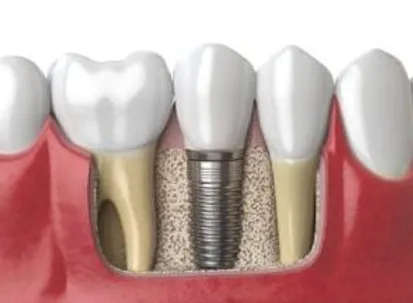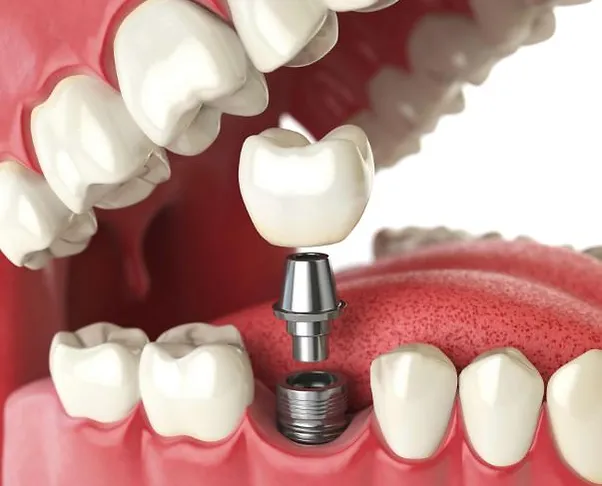Implant Dentistry
Implant dentistry is one of the most transformative advances in the dental field in the last 50 years. Our doctors have treatment planned and restored hundreds of dental implants successfully and when done with care and precision, implants are an area of dentistry with the one of the highest level of predictability and longevity.
If you are a candidate for dental implant placement and restoration we would love to discuss the process with you in more detail at your next appointment.

Who is a candidate for implant placement?
What is a dental implant?
A dental implant is essentially a screw of biocompatible material (normally titanium) that is placed in the area of a missing tooth or multiple missing teeth to improve a person’s dental function and esthetics.
The implant itself acts to replace the root structure of a person’s tooth. Implants, if placed successfully, integrate with the surrounding bony tissue to form a solid connection that would be immovable and can last several decades if not a person’s lifetime. Every patient is different, however, and implant success rates can vary from patient to patient.
A dental implant forms the foundation for an implant abutment and crown. An abutment is a metal or zirconia component that engages with the dental implant and the crown is cemented atop the implant. The crown is the portion of the system that acts to replace the top part of the missing tooth. Most implant crowns at our office are made of a form of dental porcelain. Many times the abutment and crown are fabricated together as one component, as in the case of screw-retained implant crowns.


What is the process of implant placement like?
Our practice works in conjunction with a periodontist and oral surgeon to plan, place, and restore our dental implants. The first part of the treatment protocol involves tooth removal and many times bone grafting, which is completed by the oral surgeon or periodontist. This part of the procedure sometimes varies depending on a patient’s situation and is outlined in greater detail after a patient’s initial consult with the specialist.
After tooth removal and grafting, a patient is allowed to heal before the portion of the implant that functions as a tooth (the crown) is placed by our dentists. This portion of the process involves a few impressions, measurements,and sometimes pictures to create the crown that will sit on top of the implant. Once the crown is fabricated, the patient is appointed to have their crown delivered and the fit and function of the final restoration is verified.
How long does it take before an implant is restored?
Maturation for an implant site also varies. Some patients we’ve treated have had an implant placed on the same day of extraction/grafting and have had their implant restored 4 months later. Most patients have a longer waiting period for their implant to mature and stabilize. For our average molar replacement, we commonly see a waiting period of around 6 months. For a larger case with multiple missing teeth, it’s not uncommon to finish a case over the course of a year. A patient’s health, healing, grafting needs, and a number of factors weigh into how quickly an implant is restored. This maturation is very important to a the implant’s longevity and final result and if rushed, may result in implant failure.
What's the process like for restoring a dental implant?
After an implant has integrated into the bone of a person’s mouth and the oral surgeon or periodontist has verified the implant is ready for restoration, our doctors will bring you in for a very easy appointment to take measurements, impressions, and sometimes pictures to help restore your dental implant.
At this appointment, the dentists will unscrew the healing cap or healing abutment which sits atop your dental implant. This process doesn’t hurt, and patients are normally not numbed for this appointment.
After the healing cap is unscrewed, our dentists will place a impression coping, which is essentially a machined metal or partial-metal component that locks into place with your implant. We’ll take an X-ray to then verify the coping is fully seated and then take an impression or scan for the lab to fabricate your implant crown. The healing cap or abutment is replaced and at the next visit the implant abutment and crown are tried in. They are then torqued or cemented into place and you’ll leave ready to eat, brush, and smile as you did before.
How long do implants and implant crowns last?
The life span of any dental prosthesis varies from patient to patient. However, implants and implant crowns are some of the longest lasting restorations we can place for a patient who is the right candidate. Implant failure rate varies from 5-10%, and many times with proper planning and care implants can last a remarkably long time. Implant crowns, like any crown, may require replacement after 10 years or so due to crown or screw fracture. Our office minimizes these complications by using very durable porcelain in the construction of your implant crown and ensuring proper bite (or occlusion) when crowns are delivered.
Patients can do a lot to insure the longevity of their implants and implant crowns. Staying regular with dental hygiene visits, protecting their teeth with a lab-made nightguard, and avoiding destructive habits (like ice-chewing or nail-biting) are all important. All implant patients should also avoid smoking or chewing tobacco and use appropriate at-home care to keep their implant clean and free of bacteria. We’re happy to speak to you in more detail about the steps you can take to insure your implant stays healthy and functional.




